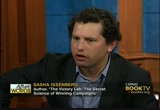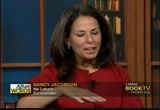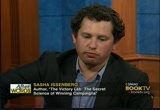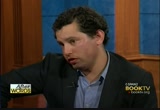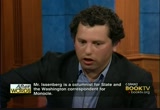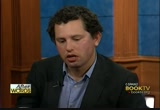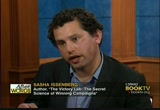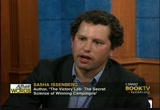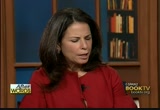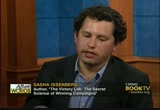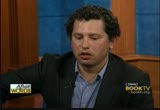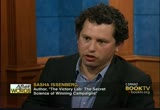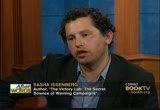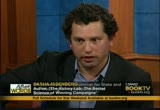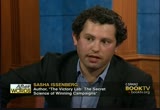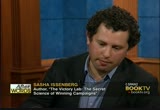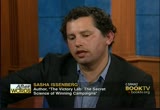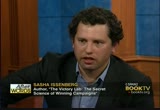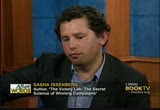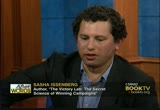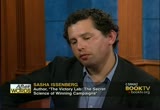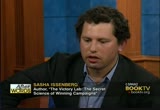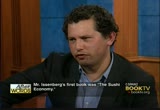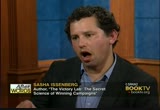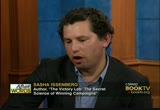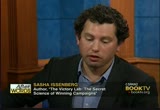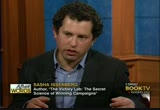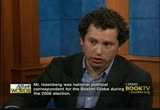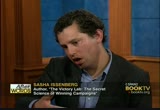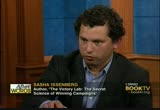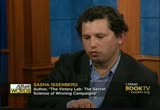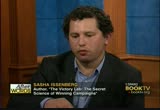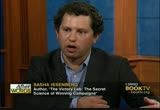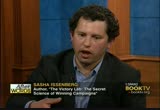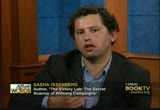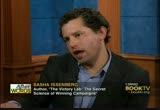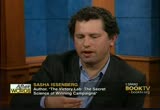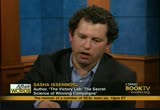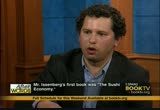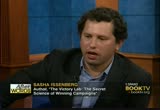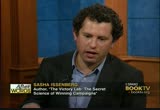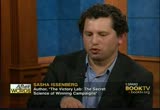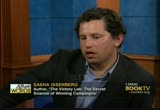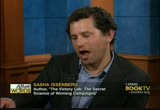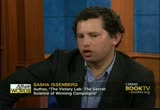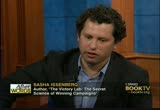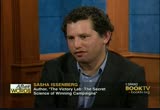tv Book TV After Words CSPAN September 30, 2012 9:00pm-10:00pm EDT
9:00 pm
the city, so much attention was being paid to increasing targeting, people who are making a tv ad, i was always talking about the people who could explain why they were doing. how do you know that, why do you do that, at some point, they did it because they had some sort of rules that wasn't really based on any research. ..
9:01 pm
the sort of message going back and forth. and after 2009i released this burgeoning wall of people doing empirical research in the campaigns and academia and institutions in washington and elsewhere convinced that is where the untold story of a lot of what's really going on in the elections these days are taking place. >> host: interesting. what do you want the reader of this book to most understand when they read this book what is that not get that you want them to come away with? >> guest: i want them to understand that what we see on
9:02 pm
tv and in the newspaper every day as sort of the campaigns is the riddle of everything that is going on. the campaigns are far more than what is set in the ads were some of the candidate goes for the candidates running mate or spouse goes and what the spokesperson says on tv i think too much of the coverage assumes this is the entirety of the campaign activity. most campaigns in all levels most of the people are seeing the campaign and doing other things coming and the -- that sort of surfacing that we see, the candidate giving a speech, buying ads and something going on tv to by the ads in many ways has that changed on decades. the focus is invisible to us. i try to write in this book is taking place with people who don't go on tv and whose names are almost entirely unknown. the outside world has changed
9:03 pm
dramatically and is changing every year, sometimes every month coming of the campaigns are getting a lot smarter about what they do, why they do it, and i think that the general campaign coverage is struggling to keep up explaining to the voters and the viewers and what they are doing and why and what the sort of thinking is under hurting all of that. >> host: you are talking about it what is causing the victory lap and you have this picture in your mind there is this lab. can you give some perspective in the campaigns now how many people are working on this stuff? was a typical campaign, how many people are working on the campaign and how many people would be working on this sort of data analysis and all the things you're talking about >> guest: the empiricism is informing everything will sort
9:04 pm
of rigorous experimental methods with her some sort of even if it's not randomized as they are through some sort of discipline testing. so the smart campaigns and the obama campaigns are emblematic of this and basically, you know, thinking of almost everything a campaign bus as it is somehow informed by the data one. you get down to the state level campaigns and they definitely are having people who work voter file managers who are just dealing with the data and targeting people just dealing with data you get to the campaigns and one of the things the romney campaign said to do this summer after they won the nomination was and increasingly that sort of function is becoming a core function of the campaign and used to be to the extent you have was fund-raising and you could buy them from the
9:05 pm
vendors or consultants, and now people will have what they call one different things but there's basically a core function of the modern campaign to have people who are especially on the voter side just country and processing data. >> host: if any of us were to go into the romney campaign or obama campaign and look at the headquarters, are there a lot of young staff? what does it look like? >> guest: in chicago dozens of people depending on how you define that, the online analytical and every state they are hiring for jobs that are data jobs and the targeting directors. the obama campaign will want thousands of people run the country and hundreds of them are directly interacting with the data every day. >> host: do you think the republicans and democrats are
9:06 pm
more adept at using this technique or is that the same level? >> guest: at the moment the democrats are ahead and we have seen leapfrogging cycles in the different parties and, you know, one of the things that becomes clear as i look back and it's one of the stories in this book is the campaigns are really resistant to innovation. you build a company come it lasts six months or 18 months. you don't always know if your budget is agreed to be in advance and your concern to the concern about the market share and invest in the research the would yield less since the day after the election. typically the person that is the chairman of the board of the campaign there are two types of them and someone has done it before and they know how to do it and maybe it's been done over and over again and it's perfectly happy with keeping this the way they work or if somebody has never done that before there is no reason why
9:07 pm
somebody that wants to be a senator or governor, sheriff should know how to run a political campaign and the more technically at fans campaigns are getting, the less the candidates should be expected to sort of understand the mechanics of these things. and so, campaigns usually are not places that are built to innovate and they are not built to learn from their failures. so when i look back over the presidential campaign you see how their reelection campaigns are sort of exceptional institutions. they exist more or less for four years in some form or another. they are then able to plan a budget over four years, staffing over four years. they often don't have a primary to distract them in the short term, and for that reason, the bush 04 campaign was revolutionary in using these aspect supplying them coming and the obama campaign of 2012 was
9:08 pm
similarly a place where it sort of exceptional innovation and statistical model technique was taking place and a part of that is that you can set a research agenda, and in chicago there was a post-mortem committee set up in november of 2008 for people who were doing the data and they put together reports almost four years ago that went through what they did right and wrong and want to fix in the future, and it's really unusual in the world of candidate campaigns or even parties where there is not usually that much continuity. but in this place if we want more than a billion dollars to answer it, what can we take on. so, that institution building that is taking place helps give them a major advantage in and in the 08 campaign as i write about in the book it is an exceptional experience.
9:09 pm
partially because of that long primary season and the huge staff they had that so many people on the campaign at the junior level came into contact with pretty sophisticated tools and analytics and a lot of those were a field director using fairly advanced motor data and in 2008 when out and went to the state parties or the labor unions or other institutions on the left and there is a sort of combination that is taking place that's i think a little more active on the democratic side right now than on the republican side. >> host: so you would give probably obama the yet vintage with this sort of technique. >> guest: the romney campaign proved itself in the primary. it's to be very smart, to be disciplined. and i think a member of the biggest success, sort of how they went about winning iowa and without drawing too much attention to it for a long time and how they won the subsequent
9:10 pm
states and all of those pretty small footprints on the ground or evidence of their ability to sort of outfox their opponents by using the data. what, they are scrambling to sort of build anything approaching the obama campaign and approaching the invention of the obama campaign the type of problems that you can solve in six months are obviously going to be a lot smaller than the problems you can try to solve in four years. >> host: do you think this campaign is going to rely more on messaging or on the targeting techniques? what is the mix? how much -- as the method still matter or is it you can just fine tune it and target better that is going to be a difference. how do you put them all together? >> guest: how must it still matters. one of the things -- this whole - in the book takes place at the last ten to 15 years has taken
9:11 pm
place in an era of the partisan polarization. one of the 2010's of being this formative moment in terms of innovation and politics for two reasons. one is obviously a very close election to the campaigns that might once have said 2% of the vote if i use the technique people would say one or 2%, i could use one or 2% come and so they're started to be a focus on the techniques that can provide a very small but measurable boosts. that's one thing that happened. another thing is we realized we were moving into this deadlock. and the chief pollster for the bush campaign in 2000 started writing a memo while the supreme court was still taking up the case and he looked at the polling data from 1984 something
9:12 pm
like 25% of americans were party switchers moved between the two parties and i think it was 7% and we were basically in that era where we were very small percentage of the population that is actually persuade will between the candidates of each party in a general election. most voters are predictable. they are undecided at various times in the campaign, but there are far fewer voters who are actively moving between the two parties as they were previously. and so when you get into that environment is a lot easier for them to visualize where they can get benefits by focusing on the voter registration as opposed to trying to persuade this small slice. i don't know if it is six per cent or 9% of our purse wadable but you're going to focus on them but we have a far better
9:13 pm
science now in understanding and a lot of is informed by the psychology research and so the science of the mobilization turnout has gotten much better it's still pretty vague and it's reinvesting in a lot of mobilization techniques because we have learned in the last decade how they work as we have two separate things you sort of know once you get somebody to implicate voting by the two per cent and now we have better targeting techniques to figure out who you talk to and about what what message or targeting but the big campaigns do targeting and analysis on the front end of the allows them to understand far more precise clean way for their turn of targets and they don't need to
9:14 pm
talk to until who the persuasion targets are and if you are narrowing your universe the people you're trying to persuade you can make your messages sharper. you can sort of focus or qualitative research and focus groups and polling and an experimental testing to get more closely to the question of what that, what is at 7%. so you are talking to 7% and then not messages that are speaking to a far broader size of the electorate to persuade them at once. >> host: i know in the book you mentioned different techniques that are used to get people to vote because in this country there is such a low level and it is the participation. can you explain some of these techniques that are used to get people? >> the best tool for getting people to turn out and vote was measured in michigan in 2006 before the republican primary.
9:15 pm
and this consultant and a center named marc ratner had this sort of practice of threatening to expose people if they didn't bode. he organized with these two political scientists at yale who had been pioneers in using the same methods people used for the drug trials to apply to the campaign techniques. these randomized controlled trials and so instead of distributing the pharmaceutical to the population to defend different types of mail or phone calls and go after the election to see who voted and who didn't for the first time we are unable to disentangle the cause and effect in particular in the political tools to read and finish again they found they were sending the voters to a copy of a letter before the election the year nancy, as you may know, you're history as a voter is a publicly available documents on file with the
9:16 pm
county board of elections. there's an election coming up in a few weeks when. we will send you and your neighbors a vote of the history and we had a line with the recipient of history like the last six elections in the senate primary and a bunch of people elected with addresses on the same block. he got death threats and tons of fathers that felt there was bullying but it turned out that it was remarkably effective that people have their friends and neighbors but whether or not they actually did go out and participate. so the paper was published in
9:17 pm
this revolutionary because it's basically because it was ten times more seven times more effective than anything that had been used before to mobilize people to vote. no campaigns, parties from institutions wanted to put their name on anything like this before because it really did seem like something of black male and the was a fear of backlash but over the next four or five years in a lot of institutions many of them on the left and academics working with unions, the dnc candidates tried to experiment how to soften the language so now it's hour of widespread practice of sending a letter out the call with a thank you treatment. thank you the publicly available record shows you voted in the last election i want to thank you for being a voter in the there is another coming of and i'm hoping afterwards i can think you again for participating people have done these over and over again.
9:18 pm
it's nowhere near as effective as a sort of threat to expose people with the behavioral psychologists that work in this space to have a secret about what that their vote history is publicly available and every campaign knows how often you vote in elections but they're visible in a sense and they can be monitored so this idea of hinting at people there's a form of surveillance that can take place and people will judge you and they want to be seen as voters they've shown time and time again that they will do it. >> host: does anybody use that in the primary because i know
9:19 pm
that is the place people are shoving up to vote, and is that a technique used? >> guest: certainly around the country people have. i don't think in this day feel better than anybody using that, but it's become so widespread in certain areas that people are now afraid that its herd and lost its potency that there is is a price for voters if they get a piece of mail that kind of the judges on that way to get once the voters have a culture to the idea that you're being surveyed, then there are sort of only so many you can get. one thing that is taking place in this period that i write in the book is behavioral psychology in forms so many aspects of human life in the last generation or so, economics has been transformed by peter guinn sites. politics, political science has been laid to accept them, and
9:20 pm
once the political scientists sort of free discovered the use of experience to go out in the real world and test the techniques and campaigns on voters with a sort of naturally went, they basically went to behavioral science textbooks and said one of the things people using to motivate the individuals to recycle or buy certain products or change their investing habits and translate these to voting and registering, and so there still is a lot of stuff that's been demonstrated in the realms other than politics that are having a sort of psychological mechanism that people who work in politics think can be translated into political behavior, so, it's almost all in the range of motivation and persuasion. there's far more that comes out of that world in that language and texture of a lot of the public local communications we have.
9:21 pm
>> host: do think most of it is motivating people to vote and less figuring out the science but in the persuasion? >> guest: people design these experiments as the easiest thing to measure is whether or not somebody voted because you have the board of elections month after and to update the fodor file and it's, you know, it is yes or no. persuasion civilized of pulling people before and after to see if they change their mind. you have to rely on them being honest in their sort of self reporting of their choices, and so the other reasons a lot of the people who started doing this work in academia were it made it very difficult to do. persuasion in the campaign but if you are doing the non-specific test you can spend
9:22 pm
the diversity dollars so there's a big body of work on the science and a lot of that informed by the sword of behavioral psychology. there's far less new science of persuasion. one thing i've written about this year is how the obama campaign is adopting these experimental methods to measure the effect of their mail and online ads and tv ads. it's more complicated and more expensive but it's a way of trying to break out of the line solely on the polls and focus groups that try to ask voters to imagine in this sort of artificial setting what would change their mind, and instead introduce them to information in the real world to believe they are basically being examined and see if it actually does change their mind. so that is a one next way of using these experimental techniques to see what really does move the voters and get out of the sort of the artificial setting of the focus groups
9:23 pm
alone. >> host: on that note with the obama campaign, since they have had four years ago time to study and now they have for years later, is there any innovative technique they're using now, any more that you can't -- >> guest: the programs are really the thing and they have been used in small narrow ways by some institutions, the afl-cio, emily's list over the years in certain states in the obama campaign has this year is a major advance part of the way the people have tested messages mr. quaid is you have a poll that asks somebody who they support and then it tells them a bunch of information and asks them again who do you support and you see if anybody moves or you ask them directly. if i told you that mitt romney
9:24 pm
had not paid taxes for x number of years would make you less likely to vote for him and some percentage of people either move when they hear of the new information or the tell you they wouldn't move. people telling you that they wouldn't move is a pretty sort of conjecture will thing. i wouldn't trust anybody that told you what they would do under a hypothetical scenario learned some information. they may or may not already know. and that is part of the problem of the polls they ask people if you know a piece of information you may or may not already know. and so in our focus groups, you bring somebody in the and show them and add and ask them again and change their mind. now you are prompting somebody to change their mind and they are being forced to watch an ad they might otherwise to now. user lady programs of dubow campaign have introduced them into the real world survey randomly assigned mail to assign
9:25 pm
to the electorate or they randomly assigned a certain markets. and then because of the polling across the markets, they can see who moves based on which message or type of fat, and then because they have all of this data, thousands of individual data points on each voter, they can look at the attributes of the people by did move and not just the people but said they would move, and so you can start to model the treats about who models mitt romney's taxes instead of just pulling at people but said they would move. and then they sort of got it down to the cycle with a few weeks to develop tests randomly assigned and distribute and measured the movement and so at the end of it you realize okay the people who are moving on the message are conservative
9:26 pm
retirees. now let's go send these ads to the conservative retirees and that is a sort of radical new way of both transferring some of these experimental techniques to measure preservation but also getting rid of sort of all of the conjectural hypothetical that the testing that have been used in the polls and focus groups into something that actually gets to the behavior of changing their mind. >> host: interesting. to do the sort of work biggs the question how extensive is this? how much money to the campaigns have to develop a level that you are talking about? >> guest: it's expensive but they invest intelligently and will tell you that it should pay for itself. so, one of the benefits of micro targeting.
9:27 pm
if you can cut ten or 20% of your persuasion and the university smarter about who you should be talking to that is ten to 20% less of your mail budget, to 20 less of your budget there are campaigns that sort of by the microtargeting abs as something the out on to their male but but in that case it is an expense and may help them win votes or not. the campaigns that sort of build certain types of family exhort targeting into the earliest strategic projections should be smarter about how they spend all of their money because they are not sending preservation messages to people that already vote for the more people will never vote for them. they are sending the right messages to people citizen that we are not going to send every woman in message about abortion now we will send the 18% of
9:28 pm
women that we model as actually movable on abortion messages and then figured out what the 82% rest of them get talked to about. so i think that that is expensive to collect the data and analyze it and it is expensive of the obama campaign has done the bill in the in-house data analytics with dozens of people many of whom are working on the private sector jobs that pay good money before. but i think that the campaign manager will tell you that will allow them to get smarter and what we will find your model and predictions and protections and in the end it pays for itself. >> host: i think we are going to take a break now and then we will be right back.
9:29 pm
>> host: i think microtargeting, everybody that has heard the phrase can you just explained to everybody what is microtargeting exactly and how was it used in these caaigns? >> guest: there are two types of command occasions. there is the mass media with the candidate talking and running its source in the newspaper, and then for the last half century it's been the tv ads and radio ads. those are very targeted in the certain media market or the certain time of day or certain channels, but you can't do a lot more sort of specificity than that. the other type of communication as voter contact. individual voters he you know who you want to talk to and you
9:30 pm
can talk about specific messages were targeted get out the vote reminders to them. here you can put together the target for something because people are registered in the specific address to have a phone number to know who you are talking to and who you are not. it's one of the big challenges of any campaign that has been true going back to wonder years in the united states. it's figuring out okay we are talking to people individually, who are we talking to and what are we talking about? and we used to have very little information on each voter. we have what is on the voter roll and it's usually the name of their age, their address, their gender. the talk about the census tracks or area and about respect which is.
9:31 pm
not everybody votes exactly through the 20 century and a lot of people are registered democrats voting republicans in certain elections and vice versa. but the hundreds of people gave me a prediction of what the political orientation was like. as of the campaign as supercomputing power increased through the middle of the 20th century in the precinct as the sort of way of dividing the electorate to serve as a basic it could face a triage of what they wanted to come who of my people are going to turn out and vote to support me already because i'm not going to waste in all were talking to them. who are the people that are going to go out and support my opponent because i don't need to talk to them either. who is in the middle. when i know who was in the middle, start to find out who i'm talking to them about. so they've offered a very basic way of providing a state or a congressional district.
9:32 pm
or if you are a democrat he would say that precincts all assume i just want to turn them all out because it is a semi democratic precinct even if i accidentally turned out people will turn out somebody that vote against me, but the margin is large enough that an aggregate will be turning out in that vote for myself and the precincts, and then when i get into the present in the middle there are 40%, 60%. there i'm going to try to individually identified each voter to know who they are going to vote for and what issues they care about. and that is where people set up phone banks. setting up phone banks is an arduous and expensive task in the 50's and 60's because you have to set up a room with zones but it as soon as you did, somebody to start calling the
9:33 pm
voters off and say who do you plan to vote for and one of the things about the united states that is different is people used to tell who they were going to vote for so then you start to come up with a list of how individuals plan to vote and may be the issues that they care about and what happened the court canvassing is trying to identify voters said they are able to sort people out. why have on my side already and who i need to keep targeting with for prez region phone calls this is the way the campaigns have always worked. but what changed at the end of the last century we started getting all of this other data about people. there was no beyond what the census knew about their area and the voter registration told you about themselves. there wasn't the traditionally information but a lot of it was collected by commercial
9:34 pm
marketers or the credit rating agency which really had an interest in accumulating as much possible information about the demographics and the consumer habits, the lifestyles. what happened started in the late 1990's was people and politics discovered that they could fuse what they knew about geopolitically and the precinct but all these other sources of information and use statistical modeling techniques to basically run algorithms that could predict how you would answer the question who are you voting for. so instead of any given state having to set up phone banks or canvases that not on the doors of people in the precincts that are in the middle you could use these modeling techniques to produce what each of those people would say and then you would do the same thing which is
9:35 pm
the people that are in the middle you still send them male but no at individual will you wouldn't be writing people based on their geography or based on their voter registration comes of this technique to called into doesn't become to those of four in the bush campaign and was the first major campaign to sort of successfully design and implement a system where this kind of microtargeting form of the campaign did. what it does is used tons of available information to sort of automate the process of predicting how somebody is going to vote so that you are no longer doing the tree ghosh by the present but by the individual club and now i can take to people that have been neighboring apartments and without knocking on either of their door predict who's likely to be with me and still be undecided and then come up with a separate treatment for each of them. >> host: the need for all of
9:36 pm
the traditional door-to-door and all of the outcome is that subsided? do we not need that as much in these campaigns? >> guest: campaigns like the obama campaign is smart like that. they do send people out to do the i.t.. in a statistical model in 2008, the obama campaign was basically modeling the electorate in the swing states every week which was to say that they would put out tens of thousands of pay phone calls and all the volunteers doing the talking to the voters and that is all of the data their body for the commercial lenders feeding into these algorithms and every week they come up with a new projection of how each individual would vote and whether they would vote and allowed by the canvassers to talk to people about particular issues, and so, there is less of
9:37 pm
a need to do all of your identification work individually. it helps to have the volunteer activities. but then one of the shift in the obama campaign this year that they are going to be using the canvas for more for persuasion and not just for the ayittey in his berkeley the campaigns usually thought of it as i used my volunteer to do this sort of a grunt work of going out and asking people who they are going to vote for and that puts together a mail list then they give the 100 names and he will make abortion grocers and put them in the mailboxes. now you can do a lot of the sort of predicting what people are likely to be responsive to the message on abortion and then maybe use your volunteers like the obama campaign you have a circuit of people willing to
9:38 pm
help and may be used in the amount and have a conversation with them. one of the things that has come out of this body of experimental work is that meaningful volunteer person-to-person communication means something and it has an effect that the pay call centers don't have. when the callers have what they call chatty calls the they don't go by the script of verbatim but they are able to improvise a little bit and sound more natural, people on the other and clearly perceived that because it makes them more likely to turn out after they've had that conversation. so, you know, one of the sort of themes running through the book is that this is all high-tech modern stuff that is made possible by massive collections
9:39 pm
of data taking place by advanced modeling techniques, computing power, all things that didn't really exist 20 years ago in the form they do now. but, if there has been a real awakening in the politics we've seen in the last decade in number of campaigns, the been campaign in 04 and the bush campaign and the atomic campaign and 08 that had a real volunteer culture i don't think those are in conflict, so i think that the campaigns are recognizing that because the targeting is better and that because the person-to-person human interactions actually do make a difference that they can make a direct time of the volunteers more effectively, so the campaigns that are intelligent are integrating the two in a way
9:40 pm
that make themselves supporting not in conflict with another. that is what you will see on the sidewalks and in the field offices that are opening up as the campaign using very advanced statistical modeling techniques. lots of data that they have spent quite handsomely but it's all in the service of figuring out who do you get your volunteer to talk to and in about what. that is one of the things when i look back at this as hardening i think it is precisely not -- everyone wants to see the big brother in moment. they know more about what moves you and in many ways what we're seeing is sort of the opposite which is the campaigns are also seeing the value and they can now measure the value of your interaction. so smart campaigns want to figure out how to allocate those as intelligently as the allocate their tv. >> host: personal touch still
9:41 pm
matters. >> guest: i think it used to be some of what you got a personal touch is better that the campaign is also really resonant to trust the volunteers to talk to people. so if there was a certain type of -- campaigns are still centralized and the obama campaign is as centralized as any of them, but since we are now able to measure the value of certain types of volunteer actions of people and campaigns are willing to conceal a little bit of control and not assume the message is always best carried for television ads or mail that's designed in the headquarters, but that there is a benefit to having people talking to people especially if you've done the difficult invisible work of telling which people to talk to win and about what so that is the tension the campaigns are weighing. i looked at the obama campaign in 2008 especially because they were quite good that sort of
9:42 pm
molding this left brain and right brain approach to the campaigns and they were able to affect lots of money and advanced data and also lots of volunteers and field staff and working through that is one of the things that will be the most important in figuring out how campaigns can balance the need and desire to control the message and centralize the tactics and strategy but also maximize the energy and talent and value of their supporters doing things on their own to other voters. >> host: there's going to be the swing states where this election is going to be divided i would imagine all of the stuff you are talking about is going to be focused like a laser on some of those states. can you just remind us what the states are and is that true most of these techniques are going to be targeted.
9:43 pm
>> guest: in more less a dozen states now we may move from week to week. one thing that is important to think to realize is that not all swing states are equal or a light. we tend to think of them interchangeably and to see the set of pulling has a bunch of states that are all between 46 to 49% and the campaigns are on the air and the swing states are all serve in the same category, and campaigns are deciding where to compete and how they can compete based on vocals and this is a central strategic document in the campaign. what i learned about the 2008 campaign, david clough recalls bible, this binder this targeting desk put together that had the vocals and they put them together during the summer, and
9:44 pm
for each state they have a total of the votes they needed to win and i think that they predicted 53% they left a little bit of a buffer of the cost on the path of how you get to the number is different and in some states it was all mobilization. in some states it was all pennsylvania is a pretty good example of that. if the democrats mobilize the supporters they have in the state does it have to victory just to the mobilization and some that rely on persuasion. ohio is a pretty good exceed of that. and the states that rely on registration. the number of persuasion targets turnout their registration target's and they would be radically different. north carolina they knew they had to register voters stephen be in play.
9:45 pm
but that does is strategically you are doing different things. you are going to spend money differently and go to different parts of the state. it may look outwardly the campaign is competing in the equally, but i'm pretty sure that within the campaign they are thinking really differently about where they're putting their tv ad and where the candidate goes. one thing i write about in ohio in 2008 on the obama campaign there was one little example was john legend to the small concert i can't remember what the town laws, but it was not a large city and he was in columbus and cleveland for the county seat and the reason he went there was that they had seen the registration numbers were
9:46 pm
lacking in this particular area and that to reach the registration goal which the disaggregate it from the state down to this particular piece of turf they had him do towards the registration right here for the city hall or whoever to go in there wasn't that they send john legend and to persuade people but they turned him in to turn people out and that's happened broadway's everywhere server will biggest it's rare talking about in october were there competing with each campaign will be competing differently in each of them based on their vocals which are coming out of those microtargeting predictions which they think every person is considering the manner the target and they are taking every man of people that they think are as persuade the ball and
9:47 pm
that is informing where the candidate goes to read as a reviewer to -- i know it is hard to predict now but it with everything you know, is there going to be one key state that it comes down to or one or two that you are particularly interested in this for this cycle that intrigues you? >> guest: i think virginia and north carolina are intriguing to me just because they are in states to the presidential politics and so, it's interesting to see how the campaigns that don't necessarily have a sort of reflective sent tactics for a competing and then where the parties are not equal the established and are not used to winning the presidential campaigns. the one thing generally after spending a year or so talking some of the smartest people in the campaigns and people that have the most granular
9:48 pm
familiarity with not just the the in some of these statistical models about politics but also the real empirical research of the cause and effect is that i put less and less faith in people better confident about things they know where their predictions because some of the smartest people i talk about are some of the ones that are the most willing to say about a very big things. i don't know that. i don't think that it is notable. i think there's a lot incantations -- in campaigns and at least the people in politics have learned what works and what doesn't but it's also made those people far more aware of the surge of limitations of knowledge and those limitations are significant and there is a massive amount about what happens inside the elections that is unknown and at the moment less noble and anybody that speaks with too much
9:49 pm
confidence about how things are probably is not to be trusted. >> host: we have heard a lot about male and other tactics, let tv advertising. what does that whole world looked like as we see more and more of the internet coming together be in one of the same. can you paint a picture? >> guest: when is the question of knowing who you are actually shot in the ads to when you buy an add-on broadcast cable. we are getting better at that. i read about mick peery's 2006 gubernatorial election and was the first campaign to the large skill randomized experiments should assign his tv ads by media market and one of the
9:50 pm
ms. pro academic called the eggheads by his son advisor dave karni and one of these eggheads is professor of university maryland realize we talk about the media markets, but do we really know? they are a signal for the tv age are to listen to a ball game and you can hear a fallout city that you are not in the war a station realizes that almost certainly the round of the media market are not as neat circles around the city that we are used to dealing with and so the key in the up partner in a figurative student in the naval academy and a certain engineering techniques to measure with a signal goes and it turns out that the edge of the media market were nothing like what we generally think of is the media markets.
9:51 pm
so much of our conversation is very simple. how many points you put into what media market? it turns out that the media market doesn't look like the people who are inside or outside you thought would run the other side of the line and it isn't in the system. the other thing is the plants are a really crude measurement. 100 points is the average number a given person sees the ad. people have -- there been a few times where they basically allowed the political target to mention the visuals and the individual viewing habits to the voter file and model individual things, so it turns out the yes it is an average, but the average distributes of the curve as you think when you think about your tv habits of the average may be that each person sees it five times but a handful
9:52 pm
of people may see it 20 times or see it once so this is the way the ads have been bought for a generation now. on the one hand they are becoming a lot smarter about understanding when you buy a point of tv who is actually being exposed to. they are able to make much smarter less crude decisions about the conventional broadcast cable dollars and the natural substitute for thasubstitute fob advertising because you can still run the video. the video is obviously an amazingly invaluable medium that can't be replaced by mail or phone voters like to see the people that want to lead them and do a lot of things with
9:53 pm
motion picture and obviously you can run the video ads online. the big challenge we are seeing the advances of fremont now is selling as much about who people are on line and who they are off line. still, politics takes place off line and the people vote at their home address and if the republicans vote in the republican primary we know who is republican in each individual house and the challenge is making sure that we know who those republicans are and which district they live and if they are searching the web or watching videos on hulu. so the challenge three is we can't do much better than that is bringing some level of geographical political targeting to the web advertising whether it is video. until this year the internet or
9:54 pm
the communication was primarily used as a fund-raising out what -- out let and most of the reason is you can measure but effectively the work of the fund-raising online you run an ad and you can get a very good measured response rate and figure out who is donating and who's not and what they respond to. we are now starting to get enough data to use it as a persuasion and the argeo tv toole and that will allow kentuckians to have a better idea of who they should talk to online and who they should talk to on conventional tv. >> host: i know we have a couple of minutes. i want to ask to more questions privately. should the voter be concerned the campaigns are getting more and more data, and using this data? >> guest: we've always had a
9:55 pm
loss of an expectation of privacy in politics than we have in other areas. long before the internet can along we were conditioned even if we've done a frustrating from somebody that knew your name and party registration and maybe they were telling you what my colleagues called you last week and talked to you about the abortion. i'm calling to remind you you talk to my colleague about abortion and we sent a van to your house tuesday morning to drive you to the polls was called for in emeline that nobody found it i don't think that invasive, fundamentally with the campaigns are doing with a lot more data and a lot more method is not a lot beyond that. your record as a voter is public whether or not you are registered in your party registration from campion's collect that information, and one thing that i've written about this year is that based on the internet because the campaigns are afraid of the
9:56 pm
backlash of getting lumped in with the more aggressive things that consumer marketers that they are bending over backwards actually to restrict certain types of privacy restrictions are not cookies online that they are not required to beyond the legal standards from so yes the campion's know more about you but in many ways the campaigns use it to talk about the things they want to talk about, and the campaigns have no interest in doing anything other than catering to your individual needs of interest and that is what they are doing. >> host: we have a minute or two before we close. what you want to say to people listening and learning about this that are weeks away from this election, what are you looking out for and what can you give to the voter in terms of what they should be paying
9:57 pm
attention to particularly in the swing states? >> guest: sure. one of the things that comes out of this is that things that you don't think of as early as being this reply science of campaign for the places where the the distributions and the most sophisticated research and canvassing scripps. the kid walks on the door, asks a few questions. amazingly that stuff has been replaced where almost the greatest energy and insight and behavioral psychology have been brought to bear and so i would listen really closely to what people ask you on the phone, what they ask you at the door, why your mail looks the way it does because mind this is a lot of this informed by an amount of sophistication about the human mind that would shock you. >> host: well, thanks so much. the secret science of the
9:58 pm
victory lab. it's timely and provocative and it seems like it is leading the groundwork for things to come. i just want to say thank you for doing this. are you going to be spending a lot of time on the road yourself and looking at more campaigns and is convinced period of time? >> guest: i've been reporting for "slate" commesso especially writing about the nuts and bolts of the voter contact is a fun time so i will be on the road all the election date. >> host: we look forward to hearing more about it. thanks. >> guest: thanks for having me. >> that was "after words" come book tv signature program in which authors of the latest nonfiction books are interviewed by journalists, public policy makers, legislators and others familiar with their material. "after words" airs every weekend
9:59 pm
on booktv at 10 p.m. on saturday, 12 p.m. and 9 p.m. on sunday coming and 12 a.m. on monday. you can also watch "after words" on line. go to booktv.org and click on "after words" in the book tv series and topics list on the upper right side of the page. next, howard discusses his book "seal team six memoirs of an elite navy seals am i per." this is about an hour. [applause] thank you for the introduction and thanks for having me. before we get started, but recovered a couple things. >> [inaudible]
162 Views
IN COLLECTIONS
CSPAN2 Television Archive
Television Archive  Television Archive News Search Service
Television Archive News Search Service 
Uploaded by TV Archive on

 Live Music Archive
Live Music Archive Librivox Free Audio
Librivox Free Audio Metropolitan Museum
Metropolitan Museum Cleveland Museum of Art
Cleveland Museum of Art Internet Arcade
Internet Arcade Console Living Room
Console Living Room Books to Borrow
Books to Borrow Open Library
Open Library TV News
TV News Understanding 9/11
Understanding 9/11